TheERIE PHILHARMONIC



A Growing
Crescendo for Erie’s Economy
economic impact
August 2023
The Erie Philharmonic is proud to share this economic impact report, which highlights the myriad ways the Philharmonic has positively influenced Erie County and the Commonwealth. We knew our impact was significant, but this report demonstrates beyond dollars and cents the magic of our work to enhance the economic and cultural vitality of the Erie community.
For more than a century, the Erie Philharmonic has been entertaining audiences and drawing patrons to downtown Erie. Our talented musicians and inspired repertoire invite music lovers from across the country to visit the town on Presque Isle. Visitors experience the magical performances of world-class musicians under the direction of Music Director Daniel Meyer.
The engaged audiences who walk through our front doors draw in talented musicians who want to share their gifts of music with a concert hall full of patrons. We have become a best practice for audience attraction and retention for larger orchestras, knowing the secret to success is an engaged community, inspired musicians, and leading by example. The orchestra is a driving force behind Erie’s vibrant arts community and a stabilizing economic influence in Downtown Erie.
Our economic impact goes far beyond the walls of the Warner Theatre. The Erie Philharmonic is a cultural asset and an economic generator for the city, county, and state. We work with local businesses to purchase goods and services, and we help keep music alive in schools and communities. The Philharmonic has been committed to the economic and cultural vitality of our region for more than 100 years, a feat shared by few orchestras of any size.
Our recent economic study measured the impact of the Erie Philharmonic at the county and state levels. In 2022, the Erie Philharmonic supported:
▪ $10.3 million generated in economic impact annually throughout Pennsylvania
◦ $8.6 million generated in economic impact in Erie County
▪ 141 jobs supported and sustained
▪ $546,786 contributed in local and state taxes
▪ 260,950 patrons
The Erie Philharmonic has hit all the right notes – engaging audiences, sharing a love of classical music with the community, and bringing talented musicians to our venue. Through our performances and outreach, we have always been an economic and cultural asset to Erie County and to the Commonwealth. In the following pages, you will learn more about our collection of programs that have impacted Erie for the past century and our continued plans to support the cultural landscape of our community for years to come.
Parker Philips, Inc. is a women owned, WBENC certified, full-service consulting firm that brings a uniquely effective combination of deep expertise in economic impact, research and strategic communications. Parker Philips prides itself on delivering high quality work that is unique to each client and their needs.
The Parker Philips team has worked extensively in the government, corporate, and non-profit world. Our commitment to statistically valid and industry respected methods ensures a defensible report that is conservative.
Parker Philips is headquartered in Erie, PA with offices in Austin, TX, Philadelphia, PA, Springfield, MO, and Youngstown, OH.
Dear Friends of the Phil -
Executive Director, Erie Philharmonic
EXECUTIVE SUMMARY 2 INTRODUCTION TO THE ERIE PHILHARMONIC 4 ABOUT THE STUDY 6 “IT’S A BIG CITY THING THAT WE DO”: ERIE PHILHARMONIC’S COMMUNITY IMPACT 8 ACCESSIBLE WORLD-CLASS MUSIC 8 DRIVING AREA TOURISM 10 TURNING WORLDWIDE SILENCE INTO BEAUTIFUL MELODIES 12 THE JUNIOR PHILHARMONIC AND YOUTH IMPACT 13 REACHING NEW HEIGHTS WITH THE ERIE PHILHARMONIC YOUTH CHORALE AND JUNIOR CHORUS 16 GIVING BACK AND COMMUNITY INVOLVEMENT 18 THE ERIE PHILHARMONIC DRIVES ECONOMIC IMPACT 20 CREATING AND SUSTAINING JOBS IN ERIE COUNTY 22 GENERATING LOCAL AND STATE TAX REVENUES 23 CONCLUSION 25 APPENDIX A: TERMS & DEFINITIONS 26 APPENDIX B: DATA & METHODS 27
THE ERIE PHILHARMONIC: A GROWING CRESCENDO FOR ERIE’S ECONOMY
For more than a century, the Erie Philharmonic has shown the community how much they love classical music, even if they did not know they loved classical music. Much like the story of Erie itself, the Philharmonic has a rich history of reinvention and evolution. By bringing the sights and sounds of a big city orchestra to the “Town at Presque Isle,¹” the Erie Philharmonic has contributed to the cultural and economic vibrancy of the region.
In The 2022-23 season
6 concerts outside the City of Erie
70 musicians perform each concert
195 musicians throughout the season
31,773 measures played per musician
2,224,110 bars played during the season
The Erie Philharmonic at-a-glance
2
¹Mary M. Muller, "A Town at Presque Isle": A Short History of Erie Pennsylvania to 1980 (Erie: Erie County Historical Society, 1991).
The Erie Philharmonic: BY THE NUMBERS
$546,786 generated in state & local tax revenues
$10.3 Million generated in economic impact in FY2022
141 jobs created & sustained
1,133 hours volunteered annually
with $8.6 million generated for Erie County and $100+ million generated over 10 years
260,950 patrons
$33,933 donated in time & charitable giving by staff and community volunteers
3
INTRODUCTION TO THE ERIE PHILHARMONIC

The Erie Philharmonic is one of the oldest professional orchestras in the nation, tracing its story back to 1913 when the Erie Symphony Orchestra first debuted their 50-piece ensemble concert of “Sacred Music.” Since then, the orchestra continued to grow, despite World War I causing a brief interlude. By the 1940s, the Erie Philharmonic reached professional status and created the Erie Philharmonic Society, which helped sponsor the orchestra and offered union-scale wages to all members. In 1942, the orchestra became a charter member of the American Symphony Orchestra League.²
following year (1953), then-Music Director James Sample and then-President William Schuster established the Erie Junior Philharmonic³ as a continuation of the Erie Philharmonic Civic Orchestra, started in 1947 by then-Music Director Fritz Mahler (the Junior Philharmonic acknowledges 1947 as their first official season). The Chorus and the Junior Philharmonic – along with the Erie Philharmonic itself – grew the cultural profile of the city of Erie and surrounding communities.
The 1950s ushered in an expansion of the Erie Philharmonic’s reach in the community. The Erie Philharmonic Chorus was created in 1952, and in the
²https://www.eriephil.org/archives
After James Sample’s tenure ended in 1967, the Erie Philharmonic welcomed six world-class music directors until the current director, Daniel Meyer, took the reins in 2007.4
³https://www.eriephil.org/archives 4https://www.eriephil.org/archives 4
“The impact of seeing a packed concert hall or patrons enjoying a performance in their community is immeasurable. Our musicians, patrons, sponsors, and staff realized our cultural value. Our economic impact shows that the Erie Philharmonic is striking all the right notes drawing in patrons, sponsors, and musicians from near and far.”
Steve Weiser, Executive Director, Erie Philharmonic
The turn of the 21st century presented many hurdles that would hamper the arts community: the deindustrialization of the Great Lakes region, the advent and takeover of the internet for peoples’ entertainment, and the decreased investment in arts in education. The ultimate in unforeseen challenges was the onset of the COVID-19 pandemic in 2020. Many similarly sized orchestras are struggling as a result of the pandemic. However, the resiliency, talent, and cultural significance of the Erie Philharmonic to the region helped the orchestra not only survive but thrive. The newly-renovated Warner Theatre, which opened its doors again to the public in 2022, gives the Erie Philharmonic an excellent springboard for the next phase of the orchestra’s story.
“Patrons of the Erie Philharmonic are willing to experiment and to accept and enjoy the exciting repertoire being performed by the musicians playing in the orchestra. We've built a degree of trust with the audience that when we take the stage, we believe in the music we're playing, that it has something to say on an emotional, intellectual, or, at best, spiritual level, where the listener is lifted out of their seat and transported to some other realm. There is a shared joy between the musicians and Erie audience.”
Daniel Meyer, Music Director, Erie Philharmonic
5
ABOUT THE STUDY
In May 2023, the Erie Philharmonic engaged Parker Philips Inc. to measure the economic contribution of the Erie Philharmonic to the city, county, and surrounding communities. The goal of this analysis is to tell the Erie Philharmonic’s story from a numbers and narrative perspective. To develop this report, Parker Philips gathered financial and employment data about the Erie Philharmonic, interviewed key stakeholders and members of the community, surveyed audience members, and researched secondary data and information to inform the writing and key messages.
The primary tool used in the performance of this study is the Input-Output model and data set developed by IMPLAN Group LLC. Financial data used in this study was obtained from the Erie Philharmonic and included the following data points: operational expenditures, capital expenditures, and payroll and benefits for employees for FY22. Secondary data was used to estimate spending by patrons (day and overnight). Additional information on the methodology and assumptions used to complete this study can be found in Appendix B.
The impact presented in this analyis was calculated for three types of impact: direct impact, indirect impact, and induced impact. The indirect and induced impacts are commonly referred to as the “multiplier effect.” The graphic to the right provides an overview of the types of impact detailed in this report.
DIRECT
Investment in construction and expenditures for operations

INDIRECT
Purchases from local suppliers
INDUCED
Household spending from earnings of direct and indirect expenditures

6
Data Source: The Erie Philharmonic
Study Type: Economic Contribution Analysis
THE ERIE PHILHARMONIC STUDY PROFILE

Geography: Erie County and Pennsylvania
Study Year: Fiscal Year 2022 (FY22)
Methodology: IMPLAN
7
ACCESSIBLE WORLD-CLASS MUSIC
The Erie Philharmonic is dedicated to making music accessible for all individuals by breaking down perceived barriers to entry and shattering myths about classical music – myths like musical performances are only for the wealthy or are enjoyed by “older crowds.” Through its performances and its programs, the Erie Philharmonic works to expand its outreach so that all Erie residents can love classical music.
“At the Erie Philharmonic, we want to provide our audience with a sense of ownership, to instill a love of classical music that reduces perceived barriers. I remember seeing a member of the community at the gas station. He told me I 'looked different without my wings.' I realized the individual was teasing me and referring to my tuxedo tails. While he was not what one may imagine as part of a stereotypical classical music audience, he obviously appreciated the cultural impact of the Erie Philharmonic. Showing people that they love classical music is one of the greatest impacts our organization can have.”
Ken Johnston, Erie Philharmonic Concertmaster
It's more than just the music; the Erie Philharmonic under the leadership of Steve Weiser and Daniel Meyer also strives to educate the broader community during performances. Meyer embraces the curiosity of newcomers and attention of veteran guests by explaining musical pieces before the orchestra plays so the audience can learn while appreciating the music. The dress code for the concerts is more relaxed compared to other orchestras, opening the performances up to a broader audience and encouraging the community to come as they are.
“The Erie Philharmonic illustrates that the arts are vibrant in Erie. It makes my heart warm when I go to to a concert and see so many people, not just retirees, but people my age and younger, that appreciate the high quality performance given by the Erie Phil. It’s a ‘big city‘ thing we are doing.”
Scott Miller, former Erie Philharmonic Board President
8
“IT’S A BIG CITY THING THAT WE DO”: ERIE PHILHARMONIC’S COMMUNITY IMPACT
Increased accessibility does not compromise the quality of the music. Musicians from all over the world come to Erie and often notice that the community appreciates their music in a new way, going beyond what musicians might experience in other cities. During one particular performance this season of “Beethoven 7,” the standing ovation at the end of the concert lasted eight minutes. “I actually timed it because I figured it would happen and they just didn’t stop,” remembered Dana Gilmore.
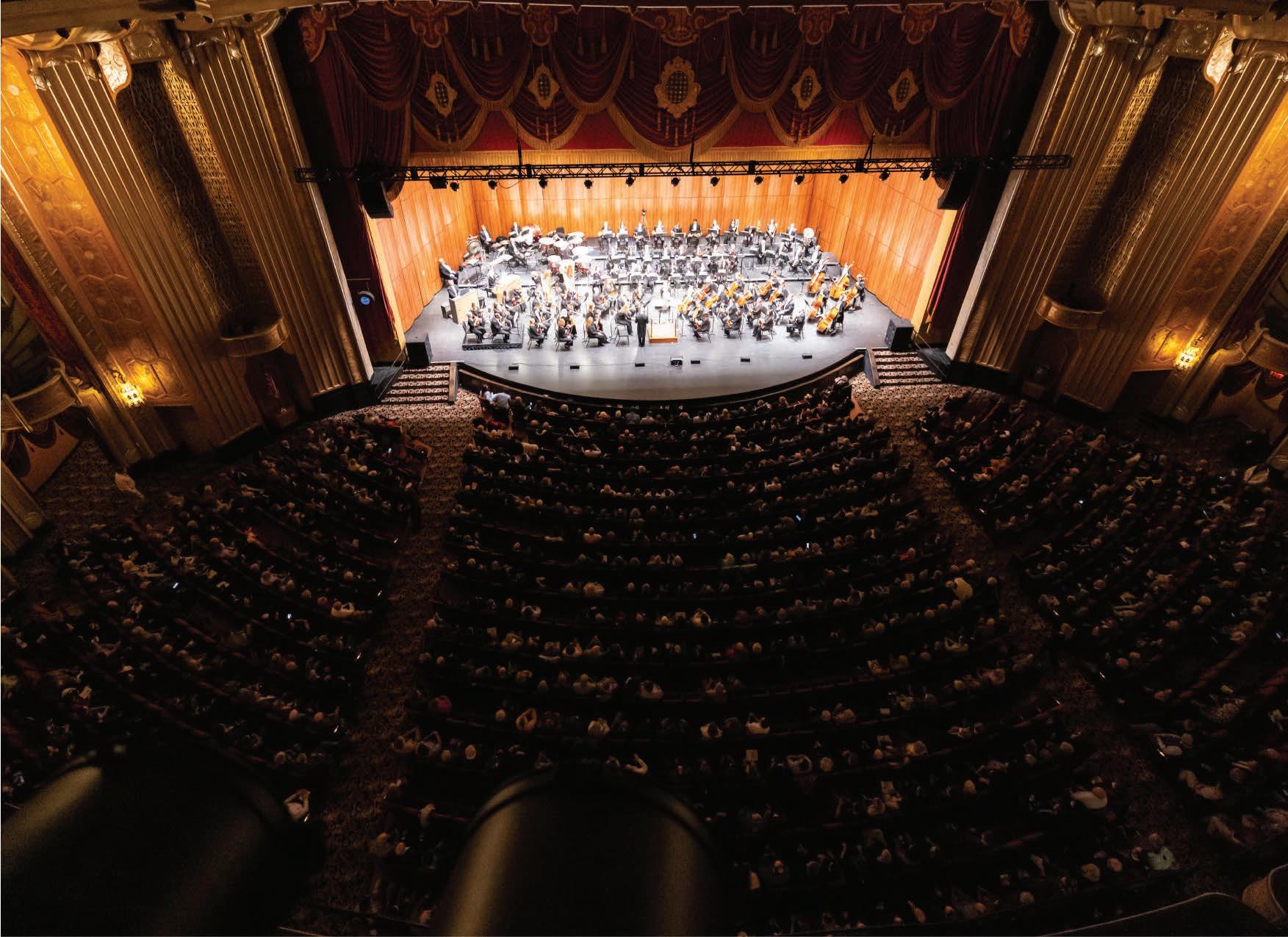
9
DRIVING AREA TOURISM
The tourism industry in Northwest Pennsylvania is on its way to a full recovery from the impacts of COVID-19. Presque Isle State Park, one of the area’s most popular attractions, attracts 4.9 million annual visitors.5 This vital part of the economy helps power the Erie region and contributes to the overall vibrancy of the area. In addition to renovations to attractions such as the expERIEnce Children’s Museum, the Presque Isle Lighthouse, the Erie Sports Center and Fun Park, and many others, the renovations to the Warner Theatre and the Erie Philharmonic’s performances have strengthened the Erie County tourism ecosystem. By several metrics, the tourism industry is now performing beyond pre-pandemic levels, and the Erie Philharmonic is an integral part of this economic asset.
When analyzing the spending behaviors of these visitors, the impact of the Erie Philharmonic is undeniable. In 2022 throughout Erie County, hotel occupancy reached 51.8% (+4.2% from the year prior) and the average visitor spending reached $178 (+13% from the previous year).6 Local residents (88% of patrons) spend an average of $33 when attending a performance, day visitors traveling more then 50 miles (9%) spend an average of $79, and overnight visitors (3%) attending the Erie Philharmonic, spend an average of $247 on their visit.
5https://www.yourerie.com/news/presque-isle-state-park-readying-for-the-masses/ 6https://www.visiterie.com/assets/2022-VE-Annual-Report-Final-compressed.pdf
ERIE PHILHARMONIC

PATRONS
LOCAL DAY VISITS
NON-LOCAL DAY VISITS
OVERNIGHT VISITS
3% 9% 88%
10
On the macro-level, the Erie Philharmonic generates $10.3 million in economic impact for the commonwealth of Pennsylvania – 86% of this impact stays right in Erie County.

11
TURNING WORLDWIDE SILENCE INTO BEAUTIFUL MELODIES

When a global pandemic induced a deafening silence bringing a busy world to a standstill, the Erie Philharmonic sent a postcard to its season ticket holders and supporters that highlighted a single image: a musical rest. The rest signaled that while the onset of the pandemic would mean a closure of the Erie Philharmonic, the closure would only be temporary. Not only has the Erie Philharmonic survived, it has thrived. The Philharmonic’s music provided hope and entertainment for the community during a time when both were sorely needed.
Innovation during the COVID pandemic made this reality possible. The staff of the Philharmonic quickly sprang into action to schedule a series of televised concerts broadcast on the local PBS affiliate, WQLN, and to book outdoor concerts. These efforts to provide music to the community when physical attendance at the Warner Theatre wasn’t possible were seen by many as a welcome port in the storm; people in the Erie community and beyond found a welcome friend, “the Phil.”
Maura Pelinsky, a First Violinist with the Erie Philharmonic, described these virtual and outdoor concerts as a gamechanger during the pandemic-related shutdowns: “it was a door that opened” for people who might not have experienced an Erie Philharmonic concert. Many people from out of town and out of state tuned in and raved about the performances on social media.
The Erie Philharmonic also partnered with several local restaurants to pair their virtual concerts with restaurants that offered takeout during the early months of the pandemic. This partnership gave the Erie community a night that resembled something normal during a period of great uncertainty. It also meant local businesses could bring in more customers and kept the local economy afloat.
A silver lining of the pandemic closures was when the final steps towards the renovation and reopening of the Warner Theatre became a possibility. After over two decades of delays, this pause allowed for time to finally complete the project and give downtown Erie the glow of the marquee lights once again.
12
THE JUNIOR PHILHARMONIC AND YOUTH IMPACT
The Erie Junior Philharmonic is one of the oldest youth orchestras in the country and continues to provide a world-class opportunity and experience to the young people of Erie. “It was the thing to do, everyone auditioned for the Junior Philharmonic,” Maura Pelinsky recalled her experience in the Junior Philharmonic. “It had just an incredible reputation. If you made it into the Junior Philharmonic, you were something.”
Many members of the Erie Philharmonic, as well as Erie Philharmonic board members and staff, got their musical start in the Junior Philharmonic. In an era when the arts face almost-constant budget cuts from local school districts, the Junior Philharmonic helps to keep the love of music alive in Erie.
“If you really want to be proud of serving on the Erie Philharmonic board, go to a Junior Philharmonic concert. It will really make it seem like what you’re doing with your time as a volunteer for the Philharmonic is most worthwhile.”
Wally Knox, former Erie Philharmonic Board President
In addition to the Junior Philharmonic, the broader organization is deeply embedded in the surrounding school districts.
Erie children around the city are exposed to high-quality music education as early as preschool. The Erie Philharmonic facilitates a 60-day music residency program in area preschools. This incredible program gives children the cultural and educational enrichment that music provides and keeps the love for the arts going in the Erie community. Educators rave about the effects of the collaboration between the Erie Philharmonic and the school system. The orchestra regularly performs in various arrangements to student audiences, and student groups are often invited to take part in Philharmonic events.
“When we have opportunities to take students to see professional musicians showing off their artistry in concerts, or when they come over here and visit our schools, it gives our kids an opportunity to aspire to be something professionally or just to continue music beyond their K-12 education in some capacity.”
Dana Gilmore, Erie School District Administrator
13
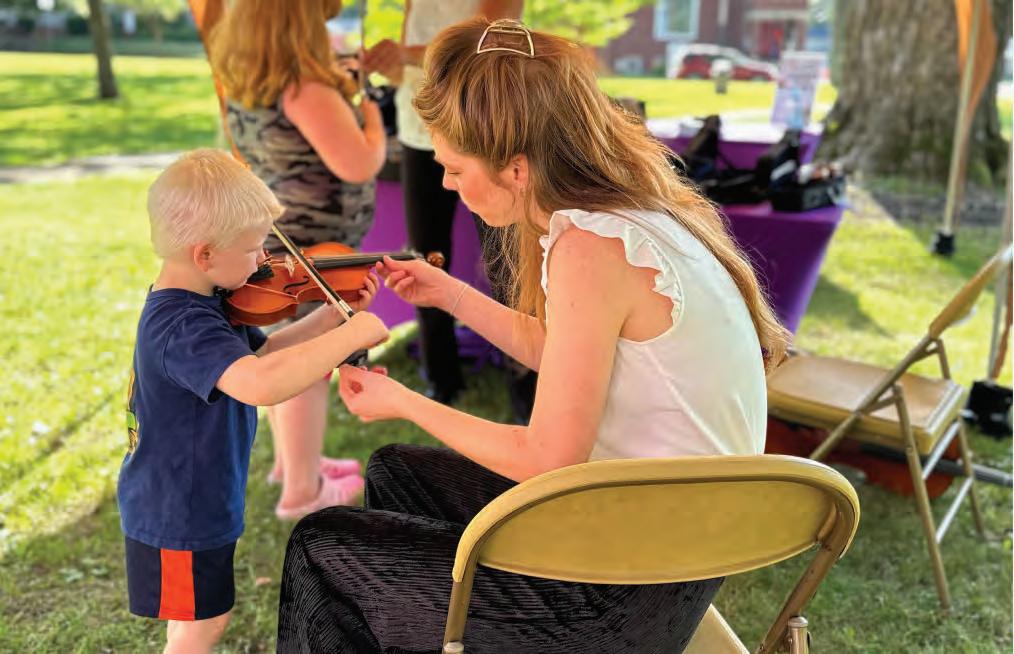
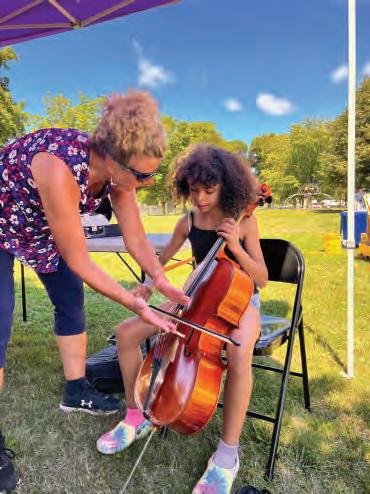
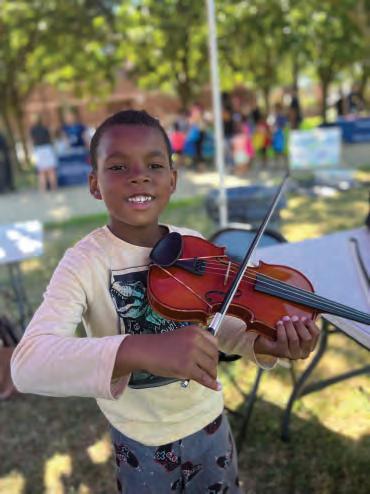

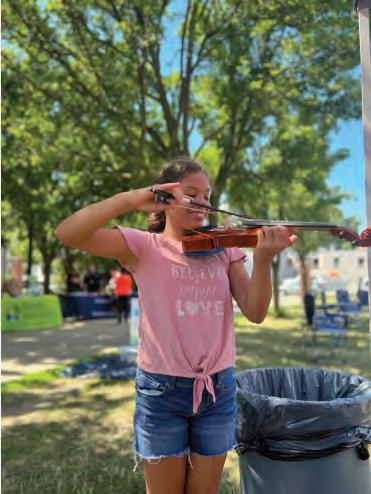

14
This focus on getting youth involved in the arts has started to change the culture in Erie. As past board president Lisa Adams noted, “the younger people that have gotten involved re-energized the longtime patrons, board members, and committee members, and we are all, you know, part of something that's bubbling in the community.”

"We have depressed pockets of our community. We've got kids who need some inspiration, who maybe have never seen the Warner on the inside or have never heard music like this before. And they could be the next great musicians, but they have to have the spark of interest and they have to be exposed. So, we do programs going into classrooms and putting instruments in kids’ hands. And we invite them into the theatre for free, to do this incredible thing where they get to see the orchestra perform on the stage. Those kids go home and they're excited about it and they want to come back, and they want to bring their families. That may make them want to pick up an instrument instead of something else."
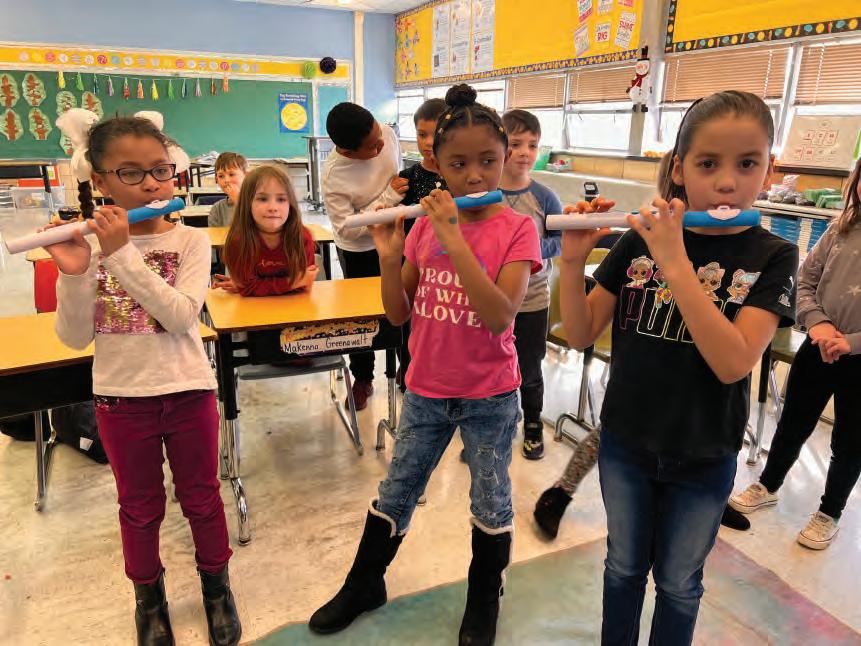
15
Lisa Adams, Erie News Now anchor, former Erie Philharmonic Board President
REACHING NEW HEIGHTS WITH THE ERIE PHILHARMONIC YOUTH CHORALE AND JUNIOR CHORUS

Along with cuts to music programs, unfortunately schools and communities are experiencing reductions to choral programs and opportunities for young people to find their voice. The Philharmonic’s Youth Chorale and Junior Chorus program, originally launched prior to the COVID-19 pandemic, represents the fastest growing vocal education initiative in the region. Comprised of 60 students of all ages, this comprehensive training program offers world-class conservatory training and performance opportunities, including televised concerts, at a fraction of the cost for programs found in major metropolitan cities.
The goal of the Junior Chorus is to create a performance ensemble unlike anything else in the region. The Junior Chorus not only offers high school students the opportunity to sing with other outstanding students, but also provides the incredible opportunity to perform with the Erie Philharmonic and Philharmonic Chorus on stage at the Warner Theatre. The members of the Chorus also sing as an independent concert choir throughout the region.
These programs also offer a state-of-the-art digital piano lab for all members to enhance piano playing, music reading, and ear training skills while developing hand-eye coordination. Skills such as these are invaluable for a young musician to learn at this vital age, especially when concerning brain development and improving a child’s cognitive functioning.7
As students receive increased training through these programs, they can carry these skills back to each of their respective music programs. This further enhances a school’s ensemble and serves as a point of inspiration for fellow students – a cascading effect that offers exponential reach for the Philharmonic’s youth vocal program beyond the students who directly participate. The more these programs can expand and evolve, the more the wide-ranging the Philharmonic’s impact will be over the course of the next generation. The success of these programs is astounding, bringing new opportunities for growth and expansion into an expanded space to meet demand.
7 https://empoweredparents.co/how-your-preschooler-learns-through-music-activities/
16
The Philharmonic Youth Chorale is designed for children and youth in fourth through eighth grades and provides foundational vocal and musical training for aspiring young singers. The ranges of ages and experience in the group will foster teamwork and create opportunities for leadership as older singers are given the responsibility of mentoring younger singers.

17
GIVING BACK AND COMMUNITY INVOLVEMENT
Nationally, volunteerism has been on a steady decline since 2013.8 A 2022 Gallup survey found that the COVID-19 pandemic interrupted both volunteerism and charitable donations. However, while charitable donations rebounded between 2020 and 2022, the rate at which people volunteered has not only failed to rebound but is lower than pre-pandemic levels.9 There are outliers in all statistical data, and one outlier in this national trend of declining volunteerism is the Erie Philharmonic. While other organizations struggle to recruit and maintain volunteers, the Erie Philharmonic’s volunteers continued to be the backbone of the organization. In 2022, the Erie Philharmonic recorded 1,133 total annual volunteer hours valued at $33,933.10
Volunteers for the Erie Philharmonic cannot be represented by numbers alone. These volunteers represent the lifelong impact that the Erie Philharmonic has on peoples’ lives in Erie County. One of the orchestra’s most consistent and recognizable volunteers, Noel Burgoyne, embodies this lifelong impact. Starting as a season ticket holder in 1968, Noel began volunteering after her retirement in 1995: “I decided I wanted to volunteer for the Philharmonic because I realized it was the most important thing in the community, as far as I was concerned.”
Volunteers ensure shows run smoothly and folks experiencing this cultural touchstone have a memorable time. The volunteers are the recognizable faces at the box office, the ushers leading a family to their seats for their first show at the Philharmonic, and the people helping to bring the orchestra into the surrounding community. The Erie Philharmonic provides such cultural richness and inspires people to give back.
People in the community give back with more than just their time; community members give back financially as well. Many volunteers are also donors. Individual and corporate generosity helps to maintain the high level of quality at the Erie Philharmonic. Individual donors generate $550,000 annually, and corporate donors contribute $200,000.
8 https://news.gallup.com/poll/388574/charitable-donations-rebound-volunteering-down.aspx
9 https://news.gallup.com/poll/388574/charitable-donations-rebound-volunteering-down.aspx

10 Value of a volunteer hour is $29.95 according to the University of Maryland Do Good Institute. 18
This generosity is most acutely felt during a time of crisis. During the early months of the COVID-19 pandemic, many businesses and community organizations were in a state of incredible financial uncertainty. Applying for PPP loans took time, effort, and patience. The Erie community, knowing how important the Erie Philharmonic is, pulled together to ensure the orchestra’s survival. Many in the community donated, with Erie Philharmonic staff sometimes finding hand-written cards with donations of $25, $50, or $100—and each card came with a personal anecdote from the sender describing the importance of the Erie Philharmonic to them and their family.






19
THE ERIE PHILHARMONIC DRIVES ECONOMIC IMPACT
The Erie Philharmonic contributes to the local and statewide economies through its expenditures on operations, capital projects, wages, the spending of staff and musicians in the community, and the spending of patrons to the orchestra. The direct, day-to-day expenditures of the Erie Philharmonic, combined with the staff, musician, and patron spending, cause a ripple effect throughout the local and regional economy.
The total economic impact of the Erie Philharmonic in FY22 totaled $10.3 million. This contribution to the local and statewide economies is a point-in-time snapshot depicting how the expenditures of the Erie Philharmonic and its staff, musicians, and patrons make an impact.
OPERATIONS CONTRIBUTION
The Erie Philharmonic operations and capital spending in FY22 contributed a total of $6 million as a result of operational and capital spending. The Erie Philharmonic’s operations generated $2.9 million in direct economic impact and $3.1 million in indirect and induced economic impact.
PATRON SPENDING CONTRIBUTION
Patron spending contributed a total of $4.3 million. Patrons to the Erie Philharmonic generated $2.2 million in direct economic impact and $2.1 million in indirect and induced economic impact.
ECONOMIC OUTPUT
DIRECT INDIRECT & INDUCED TOTAL TOTAL Patron Operations $2,256,121 $2,081,925 $4,338,046 $5,111,229 $5,227,292 $10,338,521 $2,855,108 $3,145,367 $6,000,475
Source: Parker Philips using Erie Philharmonic data in IMPLAN
PHILHARMONIC FY22 20
ERIE
DOING BUSINESS LOCALLY
The Erie Philharmonic’s operations make an impact across industry segments in Erie County. Local purchasing for goods and services totals $1.1 million annually meaning that other area businesses have a reliable revenue stream for their operations. From flowers, dry cleaning, legal services, and catering to designing and printing invitations, the purchases of the Erie Philharmonic support the local economy. The impact of this local spend totals $3.6 million and supports 97 jobs in Erie County.
AJ GRACK
ALLBURN FLORISTS
AMBASSADOR BANQUET AND CONFERENCE CENTER
B.F. FIELDS MOVING AND STORAGE
BAYFRONT SHERATON & COURTYARD BY MARRIOTT
CALAMARI’S SQUID ROW & CALI’S WEST CATERING
CHIDO’S DRY CLEANERS
CLOUD 9
COLEMAN & COMPANY
CUMULUS RADIO
DOUG AND DANIEL JONES
EDINBORO UNIVERSITY
EMTA
ERIE COUNTY CONVENTION CENTER AUTHORITY
ERIE INSURANCE GROUP
ERIE READER
FIRST PRESBYTERIAN CHURCH OF THE COVENANT
FLAGSHIP CITY PRESS
FLAGSHIP MULTIMEDIA, INC.
IN COMMUNITY MAGAZINES
JAMES B SCHWAB
JANIE’S LAKEVIEW COTTAGE
JERRY CLARK ENTERPRISES LLC
KNOX MCLAUGHLIN GORNALL & SENNETT, PC
LARESE FLORAL DESIGN
MANUFACTURER & BUSINESS ASSOCIATION



MEGA GRAFIX
MEGA MEDIA FACTORY, LLC
MILL CREEK COFFEE
NITE LITES
NOT YOUR PROBLEM CLEANING SOLUTIONS, LLC
PINEAPPLE EDDIE
PNC BANK
POTRATZ FLORAL SHOP AND GREENHOUSE
PRINTING CONCEPTS
RED LETTER HOSPITALITY
SOUTH SHORE PARTY RENTAL
THE LAMAR COMPANIES
THOMAS AYERS PHOTO
UPMC HEALTH PLAN
VNET
WICU, WJET, WSEE, WXKC FM, FOX 66, WQLN
SPENCER HOUSE*
YE OLDE SWEET SHOPPE (trade for encore lounge cookies)*
21
THE ERIE PHILHARMONIC CREATES AND SUSTAINS JOBS IN ERIE COUNTY
The Erie Philharmonic supports 141 full- and part-time jobs throughout Erie County and Pennsylvania. Beyond the direct jobs at the Erie Philharmonic, indirect and induced jobs include construction, retail, restaurants, daycare, real estate, and banking – to name a few.
OPERATIONS
Erie Philharmonic operations supported and sustained a total of 101 jobs: 83 direct jobs and 18 indirect and induced jobs.
PATRON SPENDING
Patrons of the Erie Philharmonic supported and sustained a total of 40 jobs as a result of their spending: 30 direct jobs and 10 indirect and induced jobs.
EMPLOYMENT
(Jobs)
Based on analysis by industry sectors, other jobs supported by the Erie Philharmonic outside of the entertainment sector include jobs in real estate, retail, and services.
Source: Parker Philips using Erie Philharmonic data in IMPLAN
DIRECT INDIRECT & INDUCED TOTAL TOTAL Patron Operations 30 10 40 113 28 141 83 18 101
FY22 22
IMPACT
ERIE PHILHARMONIC
THE ERIE PHILHARMONIC GENERATES LOCAL AND STATE TAX REVENUES
The Erie Philharmonic’s staff, musicians, suppliers, and related constituencies contribute to the local and statewide tax bases. In FY22, the orchestra and patrons contributed an estimated $546,786 ($253,913 direct and $292,873 indirect and induced) through local spending (operational, capital, staff, musicians, and patrons) as well as direct and indirect support of jobs. At the state and local levels, the Erie Philharmonic contributes to the tax bases through its purchasing. Specific taxes include employee and employer contributions to state and local social-insurance funds, sales and use taxes, personal property taxes, taxes paid on motor-vehicle licenses, and payments of fines and fees.
LOCAL AND STATE TAX REVENUE
County Sub-County Special Districts Sub-County General $9,851 $15,785 $25,636 $34,709 $35,077 $69,786 TOTAL State $157,605 $166,698 $324,303 $253,913 $292,873 $546,786 $51,748 $75,313 $127,061
ERIE PHILHARMONIC
FY22
DIRECT INDIRECT & INDUCED TOTAL (revenue collected by City, Township and Municipal Taxes) (revenue collected by units of government such as public school districts and fire districts) 23
Source: Parker Philips using Erie Philharmonic data in IMPLAN
Musicians from the tri-state area and from across the country come to Erie, Pennsylvania to play in the Erie Philharmonic Orchestra. The draw for musicians is simple according to Ken Heinlein, Principal Tuba in the Erie Philarmonic Orchestra, "the repetoire, the camaraderie of the musicians, and the audience keep us all coming back no matter where we are in the world. The high quality of music being performed in Erie continues to draw in the highest quality musicians and keep the seats filled."

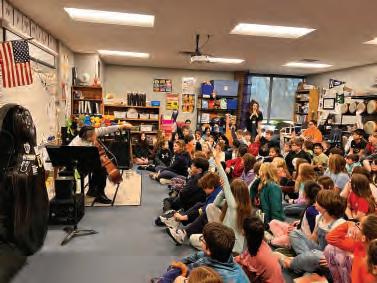


24
CONCLUSION
The Erie Philharmonic is one of the city’s most influential cultural assets. Through its inspiring and educational performances in the historic Warner Theatre to its outreach program that brings classical music to public schools, the organization is dedicated to improving the quality of life for all Erie residents. The Erie Philharmonic has a measurable economic impact within the community. In addition to its measurable impact, the Philharmonic provides an immeasurable benefit of sharing a love of classical music with others and of putting instruments into the hands of future musicians, which will influence the Erie community today and for generations to come.

25
APPENDIX A: TERMS & DEFINITIONS
Direct Economic Impact – All direct expenditures made by an organization due to its operating expenditures. These include operating expenditures, capital expenditures, and pay and benefits expenditures.
Direct Employment – Total number of employees, both full-time and part-time, at the organization based on total jobs, not FTEs.
Dollar Year – Presented in 2023 dollars.
Government Revenue/State and Local Tax Impact – Government revenue or tax revenue that is collected by governmental units at the state and local levels in addition to those paid directly by an organization. This impact includes taxes paid directly by the organization itself, employees of the organization and vendors who sell products to the organization, and at the household level.
IMPLAN Data Year – 2021
Indirect Economic Impact – The indirect impact includes the impact of local industries buying goods and services from other local industries. The cycle of spending works its way backward through the supply chain until all money is spent outside of the local economy, either through imports or by payments to value added (multiplier effect).
Indirect Employment – Additional jobs created as a result of an organization’s economic impact. Local companies or vendors that provide goods and services to an organization increase their number of employees as purchasing increases, thus creating an employment multiplier.
Induced Economic Impact – The response by an economy to an initial change (direct effect) that occurs through re-spending of income received by a component of value added. IMPLAN’s default multiplier recognizes that labor income (employee compensation and proprietor income components of value added) is not lost to the regional economy. This money is recirculated through household spending patterns causing further local economic activity (multiplier effect).
Induced Employment – Additional jobs created as a result of household spending by employees of an organization and the employees of vendors. This is another wave of the employment multiplier.
Multiplier Effect – The multiplier effect is the additional economic impact created as a result of the organization’s direct economic impact. Local companies that provide goods and services to an organization increase their purchasing by creating a multiplier (indirect/supply-chain impacts). Household spending generated by employees of the organization and the organization’s suppliers create a third wave of multiplier impact (induced/household-spending impacts).
Study Year – FY 2022 (July 1, 2021 to June 30, 2022)
Total Economic Output/Economic Impact – Includes organizational spending on operations, capital expenditures, labor income expenditures and value added to the economy as a result of expenditures made by an organization. It is the combined impact of direct, indirect and induced impacts.
26
APPENDIX B: DATA & METHODS
Erie Philharmonic provided the primary financial data used to complete the contribution analysis. Data supplied included operating expenditures, capital spending, pay and benefits, and total employees. Primary data from patron surveys and secondary data were used to complete the input-output models in IMPLAN. The study approach and economic-impact findings are a conservative estimate of impact and are based on actual financial information. The study is a snapshot in time of Erie Philharmonic’s economic impact.
OVERVIEW AND THE IMPLAN MODEL
The most common and widely accepted methodology for measuring the economic impacts of economic sectors is input-output (I-O) analysis. At its core, an I-O analysis is a table that records the flow of resources to and from companies/organizations and individuals within a region at a given time. For a specified region such as a state, the I-O table accounts for all dollar flows among different sectors of the economy in a given period. With this information, a model can then follow how a dollar added into one sector is spent and represented in other sectors of the economy, generating outgoing ripples of subsequent economic activity. This chain of economic activity created by one event is called the “economic multiplier” effect.
The primary tool used in the performance of this study is the I-O model and data set developed and maintained by IMPLAN Group LLC (formerly Minnesota IMPLAN Group Inc.). IMPLAN is a widely accepted and used software model first developed by the U.S. Forest Service in 1972. Data used in the baseline IMPLAN model and data set come largely from federal-government databases. The I-O tables themselves come from the Bureau of Economic Analysis. Much of the annual data on labor, wages, final demand and other market data come from the Bureau of Labor Statistics, the U.S. Census Bureau and other government sources.
Government agencies, companies and researchers use IMPLAN to estimate the economic activities associated with spending in a particular industry or on a particular project. The IMPLAN model extends conventional I-O modeling to include the economic relationships among government, industry and household sectors, allowing IMPLAN to model transfer payments such as taxes. Producers of goods and services must secure labor, raw materials and other services to produce their product.
The resources transferred to the owners of that labor or those raw materials and services are then used to secure additional goods and services or inputs to the products they sell. For example, an organization in a region may develop a company that produces tractors with a value of $1 million. However, to produce that product, they may be required to spend $500,000 in wages and benefits, $200,000 to suppliers of tractor parts, $100,000 for electricity, $50,000 for transportation of goods and raw materials to and from the plant, and $50,000 in various professional services fees associated with operating a business (e.g., attorneys and accountants). The suppliers will, in turn, spend those resources on labor and raw materials necessary to produce tractors. Workers and the owners of the company will buy goods and services from other firms in the area (e.g., restaurants and gas stations) and pay taxes. The suppliers, employees and owners of this second tier will, in turn, spend those resources on other goods and services whether within the study region or elsewhere. The cycle continues until all of the money leaves the region.
27
APPENDIX B: DATA & METHODS (cont’D)
IMPLAN METHODOLOGY
The model uses national production functions for more than 536 industries to determine how an industry spends its operating receipts to produce its commodities. These production functions are derived from U.S. Census Bureau data. IMPLAN couples the national production functions with a variety of county-level economic data to determine the impacts at a state and congressional-district level. IMPLAN collects data from a variety of economic data sources to generate average output, employment and productivity for each industry in a given county. IMPLAN combines this data to generate a series of economic multipliers for the study area. The multiplier measures the amount of total economic activity generated by a specific industry’s spending an additional dollar in the study area. Based on these multipliers, IMPLAN generates a series of tables to show the economic event’s direct, indirect and induced impacts to gross receipts, or output, within each of the model’s more than 536 industries.
The model calculates three types of effects: direct, indirect and induced. The economic impact of Erie Philharmonic is the sum of these three effects.
CONSIDERATIONS CONCERNING IMPLAN
There are three important points about the use of IMPLAN (or any other I-O model): It is a fixed-price model. The model assumes that changes in consumption are not limited by capacity and do not affect prices. This assumption does not cause a problem for the analysis presented here, because we are taking a snapshot of Erie Philharmonic in a specific year.
As in many studies using this type of model, the direct impacts are not calculated by the model; they reflect actual spending levels and patterns created by Erie Philharmonic. Changing the level of direct spending allows us to calculate the magnitude of the indirect and induced effects associated with the initial level of spending.
Because the model continues to calculate additional spending until all of the money leaves the region (i.e., “leakage”), the larger and more economically diverse the region, the longer it will take for spending to leave the region and the larger the impact is likely to be. For example, an employee of Erie Philharmonic may spend some amount of their income on buying a car. If there are no car manufacturers in the state or county, this spending will leave the region and the multiplier effect will stop. At the national level, a portion of that same spending by that same individual may go to a national auto producer. That spending would lead to more spending at the national level than would be captured by a more regional model. The national impact will be larger than the sum in the individual states, and the individual state impact will be larger than the sum of the impacts in its congressional districts.
28

eriephil.org info@eriephil.org @EriePhilharmonic EriePhil eriephil



































